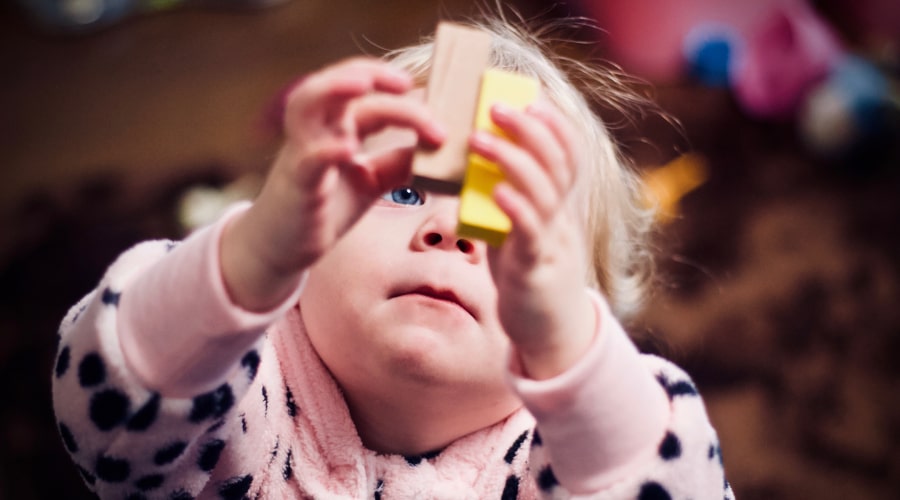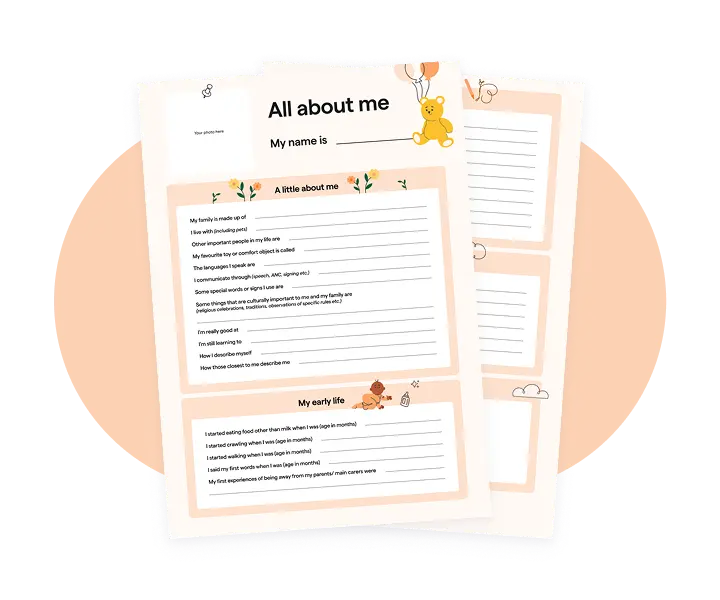settings
children
With Famly since
Let’s face it: six-month-old babies are pretty bad at making small talk.
But that sure doesn’t stop them from trying.
If you’re caring for infants, you’re familiar with the sounds of baby babble. You’ve heard the gooos and the gaaas, the bababababas, and the doodoodoodoos. What you might not know, however, is what this babble really means — or why babies do it.
Today, we’re going to decode baby babble. We’ll learn why babies even babble in the first place, how that babble develops, and how you can best support your babbling babies on their language learning journey. And to get an expert’s perspective on all that, we’ll hear from Dr. Jenny Saffran.
Jenny is a professor with the University of Wisconsin-Madison’s Department of Psychology, who focuses on how children pick up language. She also helps lead the University’s Infant Learning and Little Listeners laboratories, which focus on speech development in early childhood.
And as she explains, if we want to understand babble, we should start by looking at deaf babies.

Why doth the baby babble?
There are still a lot of unknowns in our understanding of why babies babble. But a lot of what we do know, we owe to deaf babies.
The thing is, deaf babies babble too. They start babbling at the same age as babies who can hear, and their babble sounds the same. Even deaf babies with deaf parents will babble, although nobody in the family can hear it.
That’s what leads Jenny, as well as many other researchers, to believe that part of babbling is just about babies exploring what their bodies can do.
“At the start, babies probably babble for the same reason they might suck on their toes, wiggle their arms, or any of those early body motions. It just feels good for them, and it’s kind of fun,” Jenny explains.
But there’s more to it, too.
If we expose babies to sign language, they’ll start babbling in hand signs. Regardless of whether a baby is hearing or deaf, you’ll see them start to bunch up their fists and wiggle their fingers, making simple mimics of the hand signs they see. Babies who don’t see any sign language won’t do this sort of babble — so we know that babble is, at least in part, a skill that we learn.
The truth, Jenny suggests, is somewhere in between. Part of babbling is probably just babies exploring their bodies, and what they can do. But we’ve also got good reason to believe that babies are, from an early age, sensitive to the basic concept of communication. Maybe babbling babies don’t know what’s being said, but they get that this back-and-forth is important.
But because we can’t really do a scientific interview with a six-month-old, it’s hard to know for sure.
The big ideas
A brief timeline of babbling
While babies can already understand some of the words we say by the time they’re 6 months old, their own speaking skills take a little longer to kick in.
You might look at babble as a stepping stone on that journey. Regardless of whether we know the real why behind baby babble, it’s what gives them the basic foundation to say words later on. So we’ll take a quick look at how babble bubbles up, and where it goes from there.
But before that, it’s worth clarifying that language acquisition works differently for everybody. These are average milestones — and for every average, you’ll have babies clocking in a little later and a little earlier. Both of those are completely fine too.
- 0-6 months: This is when babies start cooing — it’s the first attempt to give our vocal chords a spin. Cooing is mostly one extended vowel noise, like “aaaaaaa” or “goooooo”. At this stage, all babies’ noises sound the same around the world, regardless of their native language.
- 6-12 months: At this stage, babies start truly babbling. That’s when they start introducing some consonants by opening and closing their mouths. Yesterday’s “gooo” turns into “googoogoogoo,” or that “baaaaaaaa” might become “bababababa.” Around this time, babies’ babble is going to start sounding more like a mushy version of their mother tongue.
- 12-18 months: This is the window when we typically hear babies’ first words, and it’s when they graduate from true babble to simple speech. But this isn’t a hard boundary — babies learning to speak can and will go back to babble sometimes, and that’s just fine.

Infant-directed speech: our answer to babble
If you’re conversing with a babbling baby, you’re probably speaking a little language that scientists call infant-directed speech. You might know it as “parentese.”
Almost all cultures and languages, including sign language, have some form of infant-directed speech. Compared to our grown-up speech, it’s got three defining characteristics:
- Speaking more slowly
- Using a higher-pitched voice
- Going up and down with the pitch of your voice in an exaggerated way, like speaking in more musical tones
As Jenny explains, infant-directed speech has two big benefits for babies:
- It’s more effective at drawing babies’ attention. They love the sound of it, and it’s easier for them to separate and identify each word in our sentences. There’s some research to suggest that because of this, infant-directed speech can give babies a little boost in language acquisition.
- Infant-directed speech just sounds happy. It’s pretty hard to talk tough in that baby voice. These warm tones send babies a lot of positive emotional information, and help them feel cared for and happy.
But Jenny is careful to point out that infant-directed speech isn’t essential — babies will learn to speak just fine if they only hear grown-up speech. In general, she says, you don’t need to feel like there’s one single “right way” to support babbling babies as they build up their speaking skills.

“Humans didn’t evolve language in this environment where we think that if we say the right things to our babies, they’ll have a better shot at getting into the best university. That’s a really recent thing — we’ve been learning languages just fine for thousands of years before that."
Dr. Jenny Saffran

More speech isn’t always better
Sometimes, it can seem like there’s some special recipe to speaking skills — like if we say the right amount of words to a baby, they’re guaranteed to turn out smarter later on.
But maybe not it’s not about the amount of speech, so much as warmth and sincerity of your interactions. As Jenny says, it might help to reframe this whole question as a ‘quality versus quantity’ sort of thing.
“Just having a caregiver spew language at you isn’t going to do anything if you’re not interested in it. It’s more about tailored language, talking about the things you notice that babies are into,” she explains.
If your baby really loves a certain teddy bear, tell them a little story about it. If your baby is staring at a lamp on the table, explain what it is, what color it is, or how it works. When babies seem interested and receptive, that’s a good time to talk. But if they seem checked out, you don’t need to talk.
After all, Jenny says, babies get bored too.
“Even if a shorter interaction has fewer words, it can be a richer learning experience for babies than being with a caregiver who never stops talking, because they think they’ve got to talk to babies every minute they’re awake,” Jenny says. “My guess is that babies are tuning those adults the heck out.”
How do we best back our babbling babies?
You don’t need some magic recipe for creating a tiny linguistic genius, and you shouldn’t feel guilty if you don’t have time for dedicated “language time” every single day.
Instead of stressing over delivering some measurable boost to babies’ language skills, it’s enough to know that when we talk to babies, we’re helping build a stronger bond and a warmer relationship together.
With that in mind, let’s look at Jenny’s advice for how to speak with those babbling babies in your life:
- Make good use of baby books. Babies aren’t the strongest conversational partners, so just talking to them can feel kind of one-sided sometimes. Reading stories aloud is a great way to engage babies, without the pressure of having to think of something to say. It also introduces some vocabulary you might not come across in your daily life.
- Sing a little song to babies. “The only thing babies love more than infant-directed speech is infant-directed singing. It’s the absolute number one thing they like,” Jenny says.
- Talk about what’s going on in front of you. If you’re preparing a snack or getting dressed, just narrating your actions out loud is an easy way to give babies more spoken words. Plus, they can connect your words with things they see in the room, which often involve them directly.
- Build songs and rhymes into daily rituals. Diaper changes and bath time are more fun for everybody if you’ve got a rhyme to go with it. “It allows babies to feel like they’re predicting the future," Jenny explains. "They know there’s this warm little routine that ends with their caregiver kissing their tummy, or something like that. When they can predict that, it’s really fun or exciting for them."
Ultimately, the best support for a babbling baby is what feels best for you. It’s not about hitting some daily number of words, Jenny explains, but about making language learning a personal, meaningful experience for you and your babbling baby.
“Anything that feels natural and comfortable to the caregiver is a win,” she says. “Anything that feels imposed can feel unnatural, and I think it probably removes some of the joy from our caregiving. And babies are a ton of work, so we want to keep as much of the joy as possible.”
Try learning journals for free
Add observations, and build digital learning journals to share with families instantly. All with your completely free 14-day trial.
Get started









